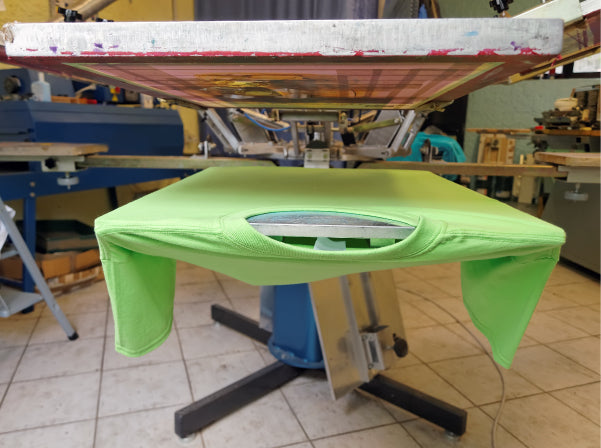
Brief History of Screen Printing

Screen printing is a form of stencilling that first appeared in a recognizable form in China during the Song Dynasty (960–1279 AD). It was then adapted by other Asian countries like Japan, and was furthered by creating newer methods.
Screen printing was largely introduced to Western Europe from Asia sometime in the late 18th century, but did not gain large acceptance or use in Europe until silk mesh was more available for trade from the east and a profitable outlet for the medium discovered.
Early in the 1910s, several printers experimenting with photo-reactive chemicals used the well-known actinic light–activated cross linking or hardening traits of potassium, sodium or ammonium chromate and dichromate chemicals with glues and gelatin compounds. Roy Beck, Charles Peter and Edward Owens studied and experimented with chromic acid salt sensitized emulsions for photo-reactive stencils. This trio of developers would prove to revolutionize the commercial screen printing industry by introducing photo-imaged stencils to the industry, though the acceptance of this method would take many years. Commercial screen printing now uses sensitizers far safer and less toxic than bichromates. Currently there are large selections of pre-sensitized and “user mixed” sensitized emulsion chemicals for creating photo-reactive stencils.
A group of artists who later formed the National Serigraphic Society coined the word Serigraphy in the 1930s to differentiate the artistic application of screen printing from the industrial use of the process. “Serigraphy” is a compound word formed from Latin “sēricum” (silk) and Greek “graphein” (to write or draw).
The Printers’ National Environmental Assistance Center says “Screenprinting is arguably the most versatile of all printing processes.” Since rudimentary screenprinting materials are so affordable and readily available, it has been used frequently in underground settings and subcultures, and the non-professional look of such DIY culture screenprints have become a significant cultural aesthetic seen on movie posters, record album covers, flyers, shirts, commercial fonts in advertising, in artwork and elsewhere.
1960s to present
Credit is generally given to the artist Andy Warhol for popularising screen printing as an artistic technique, identified as serigraphy, in the United States. Warhol was supported in his production by master Screen Printer Michel Caza, a founding member of Fespa, and is particularly identified with his 1962 depiction of actress Marilyn Monroe, known as the Marilyn Diptych, screen printed in garish colours.
Sister Mary Corita Kent, gained international fame for her vibrant serigraphs during the 1960s and 1970s. Her works were rainbow colored, contained words that were both political and fostered peace and love and caring.
American entrepreneur, artist and inventor Michael Vasilantone started to use, develop, and sell a rotatable multicolour garment screen printing machine in 1960.[citation needed]Vasilantone later filed for patent on his invention in 1967 granted number 3,427,964 on February 18, 1969. The original machine was manufactured to print logos and team information on bowling garments but soon directed to the new fad of printing on T-shirts. The Vasilantone patent was licensed by multiple manufacturers, the resulting production and boom in printed T-shirts made this garment screen printing machine popular. Screen printing on garments currently accounts for over half of the screen printing activity in the United States.
In June 1986, Marc Tartaglia, Marc Tartaglia Jr. and Michael Tartaglia created a silk screening device which is defined in its US Patent Document as, “Multi-coloured designs are applied on a plurality of textile fabric or sheet materials with a silk screen printer having seven platens arranged in two horizontal rows below a longitudinal heater which is movable across either row.” This invention received the patent number 4,671,174 on June 9, 1987.
Graphic screenprinting is widely used today to create mass or large batch produced graphics, such as posters or display stands. Full colour prints can be created by printing in CMYK(cyan, magenta, yellow and black (‘key’)).
Screen printing lends itself well to printing on canvas. Andy Warhol, Arthur Okamura, Robert Rauschenberg, Roy Lichtenstein, Harry Gottlieb and many other artists have used screen printing as an expression of creativity and artistic vision.
